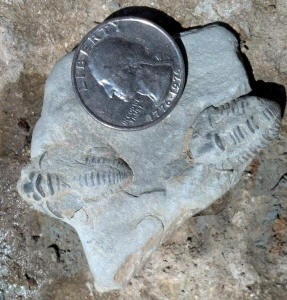The Dry Dredgers made their first outdoor field trip of 2013 a repeat visit to the creek bed in Ohio. This site exposes parts of the Maysvillian stage the Cincinnatian. The fossils from this creek are about 445 million years old. They were alive during the late Ordovician Period.
We met at 10 am in a culdesac and proceeded down the trail to the creek. The morning started out being chilly and overcast. But it cleared up later in the morning and became a nice day. Here are some pictures of the site and the fun we had.
Fossils Found That Day
The best find of the day was probably this double specimen of the trilobite
Flexicalymene meeki. Very nice. It's unusual to find
two prone trilobites beautifully preserved on one rock from a creek bead.

Photo courtesy of Steve Mccabe
And in true style of traditional paleontology, one of our younger, artistic
members was able to provide us with an illustration of the above specimens,
ready for publication in a professional journal!
Now, after a professional preparation job, here is the dual specimen all cleaned
up. Don't it clean up nice?
The double-trilobite specimen was found weathered out of the bluish colored
"butter shale" layer exposed on the bank of the creek. (next 2 pics -
courtesy of Steve Mccabe)

Here are some pictures of other Flexicalymene meeki
found on the site that day. The second photo is a Flexi that is inverted
(upside-down) in the shale.
Trilobite: Isotelus
Only fragments of the trilobite Isotelus were found, but as you can see from the
photos below, they are nice fragments.
Pelecypods (Clams or Bivalves)
This site was loaded with moulds and casts of clams. Some were larger than the
common
Ambonychia. I think those are Anomalodonta
plicata, as shown in the next two pictures. The first picture uses
a finger for scale.
In this next picture, we see a slab was found that not only has an
Ambonychia sp. and an Anomalodonta sp., but
it looks like it also has an ENROLLED FLEXICALYMENE TRILOBITE!
(Do you see it?)
Here are a couple more photos of clams that are likely to be mostly
Ambonychia sp..
There were also clams with a black film material. These "black clams" are
probably Modiolopsis sp. This black film often has
relict microstructure that reveals shell features not seen without a Scanning
Electron Microscope (SEM).
Cephalopods
As was true in other visits to this site, a large number of
straight-shelled nautiloid cephalopods were found.
Gastropods (snails)
Most of the snails found were internal moulds, such as the one below.
But good quantities of the platyceratoid gastropod
Cyclonema sp. were also found. These snails have shell features
preserved, which is typical for Cyclonema.
Brachiopods
Brachiopod: Vinlandostrophia ponderosa
Brachiopod: Zygospira modesta
Brachiopod: Rafinesquina ponderosa
Bryozoans
Ichnofossils (trace fossils)
Non-Maysvillian Fossils
Recent animals
Now let's see the April 2013 field trip to Southwest Indiana.
See previous trips to this creek bed in Ohio
Back to the Field Trip Index Page
Return to Dry Dredgers Home Page
The Dry Dredgers and individual contributors reserve the
rights to all information, images, and content presented here. Permission to
reproduce in any fashion, must be requested in writing to admin@drydredgers.org.
www.drydredgers.org is designed and maintained by Bill Heimbrock.